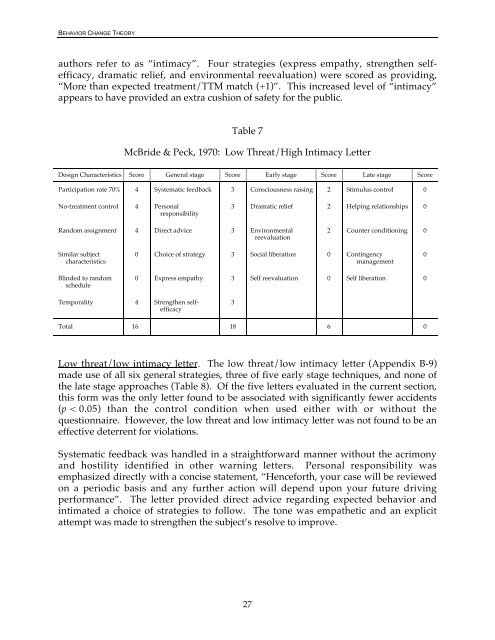Application of Behavior Change Theory to the Development
Application of Behavior Change Theory to the Development
Application of Behavior Change Theory to the Development
Create successful ePaper yourself
Turn your PDF publications into a flip-book with our unique Google optimized e-Paper software.
BEHAVIOR CHANGE THEORY<br />
authors refer <strong>to</strong> as “intimacy”. Four strategies (express empathy, streng<strong>the</strong>n selfefficacy,<br />
dramatic relief, and environmental reevaluation) were scored as providing,<br />
“More than expected treatment/TTM match (+1)”. This increased level <strong>of</strong> “intimacy”<br />
appears <strong>to</strong> have provided an extra cushion <strong>of</strong> safety for <strong>the</strong> public.<br />
Table 7<br />
McBride & Peck, 1970: Low Threat/High Intimacy Letter<br />
Design Characteristics Score General stage Score Early stage Score Late stage Score<br />
Participation rate 70% 4 Systematic feedback 3 Consciousness raising 2 Stimulus control 0<br />
No-treatment control 4 Personal<br />
responsibility<br />
Random assignment 4 Direct advice 3 Environmental<br />
reevaluation<br />
Similar subject<br />
characteristics<br />
Blinded <strong>to</strong> random<br />
schedule<br />
Temporality 4 Streng<strong>the</strong>n selfefficacy<br />
3 Dramatic relief 2 Helping relationships 0<br />
27<br />
2 Counter conditioning 0<br />
0 Choice <strong>of</strong> strategy 3 Social liberation 0 Contingency<br />
management<br />
0 Express empathy 3 Self reevaluation 0 Self liberation 0<br />
3<br />
Total 16 18 6 0<br />
Low threat/low intimacy letter. The low threat/low intimacy letter (Appendix B-9)<br />
made use <strong>of</strong> all six general strategies, three <strong>of</strong> five early stage techniques, and none <strong>of</strong><br />
<strong>the</strong> late stage approaches (Table 8). Of <strong>the</strong> five letters evaluated in <strong>the</strong> current section,<br />
this form was <strong>the</strong> only letter found <strong>to</strong> be associated with significantly fewer accidents<br />
(p < 0.05) than <strong>the</strong> control condition when used ei<strong>the</strong>r with or without <strong>the</strong><br />
questionnaire. However, <strong>the</strong> low threat and low intimacy letter was not found <strong>to</strong> be an<br />
effective deterrent for violations.<br />
Systematic feedback was handled in a straightforward manner without <strong>the</strong> acrimony<br />
and hostility identified in o<strong>the</strong>r warning letters. Personal responsibility was<br />
emphasized directly with a concise statement, “Henceforth, your case will be reviewed<br />
on a periodic basis and any fur<strong>the</strong>r action will depend upon your future driving<br />
performance”. The letter provided direct advice regarding expected behavior and<br />
intimated a choice <strong>of</strong> strategies <strong>to</strong> follow. The <strong>to</strong>ne was empa<strong>the</strong>tic and an explicit<br />
attempt was made <strong>to</strong> streng<strong>the</strong>n <strong>the</strong> subject’s resolve <strong>to</strong> improve.<br />
0
















